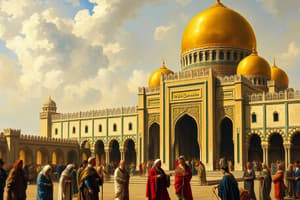Podcast
Questions and Answers
The Holy Prophet Muhammad (ﷺ) delivered his last sermon during his last ______.
The Holy Prophet Muhammad (ﷺ) delivered his last sermon during his last ______.
pilgrimage
According to the sermon, the life and property of every Muslim is regarded as a sacred ______.
According to the sermon, the life and property of every Muslim is regarded as a sacred ______.
trust
The Prophet warned people to beware of ______ for the safety of their religion.
The Prophet warned people to beware of ______ for the safety of their religion.
Satan
The sermon emphasized the rights that both men and women have over ______.
The sermon emphasized the rights that both men and women have over ______.
The noblest of mankind in Allah’s sight is the most ______.
The noblest of mankind in Allah’s sight is the most ______.
No one has superiority over another except by ______ and good action.
No one has superiority over another except by ______ and good action.
The Prophet stated that every Muslim is a brother to every ______.
The Prophet stated that every Muslim is a brother to every ______.
The Prophet crushed false claims of greatness founded on ______ or wealth.
The Prophet crushed false claims of greatness founded on ______ or wealth.
The message of the Prophet must be taken to those who could not be ______ at the sermon.
The message of the Prophet must be taken to those who could not be ______ at the sermon.
The sermon was delivered in the ______ valley of Mount Arafat.
The sermon was delivered in the ______ valley of Mount Arafat.
Flashcards are hidden until you start studying
Study Notes
Arrival of the Holy Prophet Muhammad in Madina
- Hijra occurred on 2nd July 622 A.D, marking the start of the Islamic calendar.
- Madina was originally named Yathrib and later became known as "Madina," meaning "the city."
- Four main groups existed in Madina at the time of Muhammad’s arrival:
- Muslims: Natives and immigrants from Makkah.
- Hypocrites: Individuals who outwardly embraced Islam but opposed it secretly.
- Aws and Khazraj: Pagan tribes likely to accept Islam.
- Jews: A significant and influential community in Madina.
Constitution of Madina
- Holy Prophet Muhammad aimed for harmony and security among diverse communities.
- Invited leaders to achieve a formal agreement, resulting in the Constitution of Madina (Charter of Madina).
- Key elements included:
- Defined rights and duties for Muslims and Jews.
- Guaranteed freedom of religion.
- Prohibited alliances with external enemies.
- Established conflict resolution by referring disputes to Muhammad.
Later Developments
- The Holy Prophet unified various Arab tribes under Islam.
- Implemented social, religious reforms, and administrative changes to strengthen the Islamic community.
- Conducted a significant farewell pilgrimage (Hajj) in the year 10 A.H.
Last Sermon of the Holy Prophet Muhammad
- Praised Allah and addressed the audience for attentiveness, stressing the importance of his message.
- Key messages included:
- Sanctity of life and property: Treat every Muslim’s life and property as a sacred trust.
- Caution against Satan: Reminded followers to avoid small transgressions that could lead them astray.
- Rights of women: Emphasized that both men and women have rights over each other.
- Equality among mankind: Asserted that all humans are descendants of Adam, emphasizing that piety, not lineage or wealth, defines superiority.
- Brotherhood of Muslims: Stressed that all Muslims constitute one brotherhood.
Key Teaching of the Farewell Pilgrimage
- The pilgrimage served as an important moment for transmitting teachings on performing Hajj and reinforcing the unity and ethics of the Muslim community.
Studying That Suits You
Use AI to generate personalized quizzes and flashcards to suit your learning preferences.



